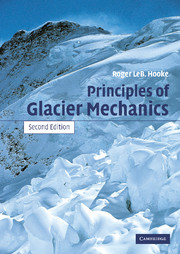Book contents
- Frontmatter
- Contents
- Preface to the first edition
- Preface to the second edition
- Physical constants relevant to ice
- Derived SI units and conversion factors
- 1 Why study glaciers?
- 2 Some basic concepts
- 3 Mass balance
- 4 Flow and fracture of a crystalline material
- 5 The velocity field in a glacier
- 6 Temperature distribution in polar ice sheets
- 7 The coupling between a glacier and its bed
- 8 Water flow in and under glaciers: geomorphic implications
- 9 Stress and deformation
- 10 Stress and velocity distribution in an idealized glacier
- 11 Numerical modeling
- 12 Applications of stress and deformation principles to classical problems
- 13 Finite strain and the origin of foliation
- 14 Response of glaciers to changes in mass balance
- Appendix: Problems
- References
- Index
11 - Numerical modeling
Published online by Cambridge University Press: 24 November 2009
- Frontmatter
- Contents
- Preface to the first edition
- Preface to the second edition
- Physical constants relevant to ice
- Derived SI units and conversion factors
- 1 Why study glaciers?
- 2 Some basic concepts
- 3 Mass balance
- 4 Flow and fracture of a crystalline material
- 5 The velocity field in a glacier
- 6 Temperature distribution in polar ice sheets
- 7 The coupling between a glacier and its bed
- 8 Water flow in and under glaciers: geomorphic implications
- 9 Stress and deformation
- 10 Stress and velocity distribution in an idealized glacier
- 11 Numerical modeling
- 12 Applications of stress and deformation principles to classical problems
- 13 Finite strain and the origin of foliation
- 14 Response of glaciers to changes in mass balance
- Appendix: Problems
- References
- Index
Summary
On several occasions when we encountered problems that could not be solved readily by analytical methods, we have referred to results from numerical models. In Chapters 5 and 10 we found, in fact, that analytical solutions to problems of glacier flow could be obtained only when the problems were quite simple. The two numerical methods that are most commonly used in modeling are the finite-difference and finite-element methods.
The analytical methods of calculus are based on taking the limit as intervals over which functions are evaluated are allowed to shrink toward zero. In finite-difference and finite-element models, in contrast, we let these intervals remain finite and assume that the functions describing the variation of parameters across them can be replaced by constants, by linear functions, or by low-order polynomials. The resulting equations turn out to be much simpler than the original differential equations, but because the domain of interest is now broken into many small intervals, one must do a large number of repetitive calculations to obtain a solution for the entire domain. Computers are thus used for all but the simplest numerical calculations. Moreover, the numerical solutions are not necessarily as accurate as analytical ones.
In this chapter, we first describe elementary numerical integration. This leads into some straight forward finite-difference calculations that can be carried out with the use of a spread sheet, a short computer program, or available mathematical software.
- Type
- Chapter
- Information
- Principles of Glacier Mechanics , pp. 288 - 314Publisher: Cambridge University PressPrint publication year: 2005



